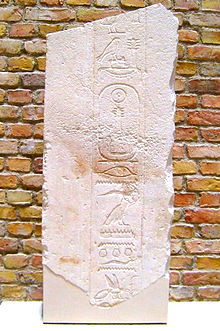| Djedkare Isesi | ||||||||||||||||||||||||||||||||||||||||||||||||||||||||||||||||||||||||||||||||||||||||||||||||||||||||||||||||||||||||||||||
|---|---|---|---|---|---|---|---|---|---|---|---|---|---|---|---|---|---|---|---|---|---|---|---|---|---|---|---|---|---|---|---|---|---|---|---|---|---|---|---|---|---|---|---|---|---|---|---|---|---|---|---|---|---|---|---|---|---|---|---|---|---|---|---|---|---|---|---|---|---|---|---|---|---|---|---|---|---|---|---|---|---|---|---|---|---|---|---|---|---|---|---|---|---|---|---|---|---|---|---|---|---|---|---|---|---|---|---|---|---|---|---|---|---|---|---|---|---|---|---|---|---|---|---|---|---|---|
| Djedkara, Izezi, Izzj, Asosi, Tankeris | ||||||||||||||||||||||||||||||||||||||||||||||||||||||||||||||||||||||||||||||||||||||||||||||||||||||||||||||||||||||||||||||
 Relief of Djedkare Isesi, Egyptian Museum of Berlin | ||||||||||||||||||||||||||||||||||||||||||||||||||||||||||||||||||||||||||||||||||||||||||||||||||||||||||||||||||||||||||||||
| Pharaoh | ||||||||||||||||||||||||||||||||||||||||||||||||||||||||||||||||||||||||||||||||||||||||||||||||||||||||||||||||||||||||||||||
| Reign | duration uncertain, at least 33 years and possibly more than 44 years, in the late-25th to mid-24th century BCE.[note 1] | |||||||||||||||||||||||||||||||||||||||||||||||||||||||||||||||||||||||||||||||||||||||||||||||||||||||||||||||||||||||||||||
| Predecessor | Menkauhor Kaiu | |||||||||||||||||||||||||||||||||||||||||||||||||||||||||||||||||||||||||||||||||||||||||||||||||||||||||||||||||||||||||||||
| Successor | Unas | |||||||||||||||||||||||||||||||||||||||||||||||||||||||||||||||||||||||||||||||||||||||||||||||||||||||||||||||||||||||||||||
| ||||||||||||||||||||||||||||||||||||||||||||||||||||||||||||||||||||||||||||||||||||||||||||||||||||||||||||||||||||||||||||||
| Consort | possibly Meresankh IV? | |||||||||||||||||||||||||||||||||||||||||||||||||||||||||||||||||||||||||||||||||||||||||||||||||||||||||||||||||||||||||||||
| Children | Neserkauhor ♂, Kekheretnebti ♀, Meret-Isesi ♀, Hedjetnebu ♀, Nebtyemneferes ♀ Uncertain: Raemka ♂, Kaemtjenent ♂, Isesi-ankh ♂ Conjectural: Unas ♂ | |||||||||||||||||||||||||||||||||||||||||||||||||||||||||||||||||||||||||||||||||||||||||||||||||||||||||||||||||||||||||||||
| Burial | Pyramid of Djedkare-Isesi | |||||||||||||||||||||||||||||||||||||||||||||||||||||||||||||||||||||||||||||||||||||||||||||||||||||||||||||||||||||||||||||
| Dynasty | Fifth Dynasty | |||||||||||||||||||||||||||||||||||||||||||||||||||||||||||||||||||||||||||||||||||||||||||||||||||||||||||||||||||||||||||||
Djedkare Isesi (known in Greek as Tancherês) was an Ancient Egyptian pharaoh, the eighth and penultimate ruler of the Fifth Dynasty in the late 25th century to mid 24th century BCE, during the Old Kingdom period. Djedkare succeeded Menkauhor Kaiu and was in turn succeeded by Unas. His relations to both of these pharaohs remain uncertain, although it is often conjectured that Unas was Djedkare's son owing to the smooth transition between the two.
Djedkare likely enjoyed a long reign of over 40 years, which heralded a new period in the history of the Old Kingdom. Breaking with a tradition followed by his predecessors since the time of Userkaf, Djedkare did not build a temple to the sun god Ra, possibly reflecting the rise of Osiris in the Egyptian pantheon. More significantly, Djedkare effected comprehensive reforms of the Egyptian state administration, the first undertaken since the inception of the system of ranking titles. He also reorganised the funerary cults of his forebears buried in the necropolis of Abusir and reformed the corresponding priesthood. Djedkare commissioned expeditions to Sinai to procure copper and turquoise, to Nubia for its gold and diorite and to the fabled Land of Punt for its incense. One such expedition had the earliest recorded instance of oracular divination undertaken to ensure an expedition's success. The word "Nub", meaning gold, to designate Nubia is first recorded during Djedkare's reign. Under his rule, Egypt also entertained continuing trade relations with the Levantine coast and made punitive raids in Canaan. In particular, one of the earliest depictions of a battle or siege scene was found in the tomb of one of Djedkare's subjects.
Djedkare was buried in a pyramid in Saqqara named Nefer Djedkare ("Djedkare is perfect"), which is now ruined owing to theft of stone from its outer casing during antiquity. The burial chamber still held Djedkare's mummy when it was excavated in the 1940s. Examinations of the mummy revealed that he died in his fifties. Following his death, Djedkare was the object of a cult that lasted at least until the end of the Old Kingdom. He seemed to have been held in particularly high esteem during the mid-Sixth Dynasty, whose pharaohs lavished rich offerings on his cult. Archaeological evidence suggests the continuing existence of this funerary cult throughout the much later New Kingdom period (c. 1550–1077 BCE). Djedkare was also remembered by the Ancient Egyptians as the king of vizier Ptahhotep, the purported author of The Maxims of Ptahhotep, one of the earliest pieces of philosophic wisdom literature.
The reforms implemented by Djedkare are generally assessed negatively in modern Egyptology as his policy of decentralization created a virtual feudal system that transferred much power to the high and provincial administrations. Some Egyptologists such as Naguib Kanawati argue that this contributed heavily to the collapse of the Egyptian state during the First Intermediate Period, c. 200 years later. These conclusions are rejected by Nigel Strudwick, who says that in spite of Djedkare's reforms, Ancient Egyptian officials never amassed enough power to rival that of the king.
- ^ Verner 2001b, p. 589.
- ^ Altenmüller 2001, p. 600.
- ^ Hawass & Senussi 2008, p. 10.
- ^ Malek 2000, p. 100.
- ^ Rice 1999, pp. 46–47.
- ^ Clayton 1994, pp. 60.
- ^ Sowada & Grave 2009, p. 3.
- ^ Lloyd 2010, p. xxxiv.
- ^ Strudwick 2005, p. xxx.
- ^ von Beckerath 1999, pp. 60–61 & 283.
- ^ Strudwick 1985, p. 3.
- ^ Hornung 2012, p. 491.
- ^ a b c d Leprohon 2013, p. 40.
- ^ Mariette 1864, p. 15.
- ^ Clayton 1994, p. 61.
- ^ Leprohon 2013, p. 40, Footnote 63.
Cite error: There are <ref group=note> tags on this page, but the references will not show without a {{reflist|group=note}} template (see the help page).
